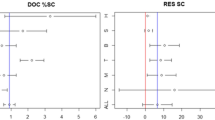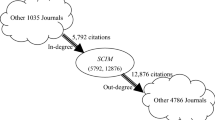Abstract
Citation analyses were performed for Australian social science journals to determine the differences between data drawn from Web of Science and Scopus. These data were compared with the tier rankings assigned by disciplinary groups to the journals for the purposes of a new research assessment model, Excellence in Research for Australia (ERA), due to be implemented in 2010. In addition, citation-based indicators including an extended journal impact factor, the h-index, and a modified journal diffusion factor, were calculated to assess whether subsequent analyses influence the ranking of journals. The findings suggest that the Scopus database provides higher number of citations for more of the journals. However, there appears to be very little association between the assigned tier ranking of journals and their rank derived from citations data. The implications for Australian social science researchers are discussed in relation to the use of citation analysis in the ERA.

Similar content being viewed by others
Notes
Typically an A* journal would be one of the best in its field or subfield in which to publish and would typically cover the entire field/subfield. Virtually all papers they publish will be of a very high quality. These are journals where most of the work is important (it will really shape the field) and where researchers boast about getting accepted. Acceptance rates would typically be low and the editorial board would be dominated by field leaders, including many from top institutions.
The majority of papers in a Tier A journal will be of very high quality. Publishing in an A journal would enhance the author’s standing, showing they have real engagement with the global research community and that they have something to say about problems of some significance. Typical signs of an A journal are lowish acceptance rates and an editorial board which includes a reasonable fraction of well known researchers from top institutions.
Tier B covers journals with a solid, though not outstanding, reputation. Generally, in a Tier B journal, one would expect only a few papers of very high quality. They are often important outlets for the work of PhD students and early career researchers. Typical examples would be regional journals with high acceptance rates, and editorial boards that have few leading researchers from top international institutions.
Tier C includes quality, peer reviewed, journals that do not meet the criteria of the higher tiers.
Exact text from: Tiers for the Australian Ranking of Journals: http://www.arc.gov.au/era/tiers_ranking.htm (accessed February 8 2010).
References
Australian Bureau of Statistics. (2008). Australian and New Zealand Standard Research Classification. Retrieved September 16, 2009, from http://www.abs.gov.au/Ausstats/abs@.nsf/Latestproducts/6BB427AB9696C225CA2574180004463E?opendocument.
Australian Research Council. (2008). ERA Indicator Principles. Retrieved December 21, 2008, from http://www.arc.gov.au/era/indicators.htm.
Australian Research Council. (2009a). Draft ERA submission guidelines: Physical, Chemical and Earth Sciences (PCE) and Humanities and Creative Arts (HCA) clusters. Retrieved January 29, 2009, from http://www.arc.gov.au/pdf/Draft_ERA_Sub_Guide.pdf.
Australian Research Council. (2009b). ERA Indicators Consultation Paper. Retrieved October 4, 2009, from http://www.arc.gov.au/pdf/ERA_indicators_consult.pdf.
Bakkalbasi, N., Bauer, K., Glover, J., & Wang, L. (2006). Three options for citation tracking: Google Scholar, Scopus and Web of Science. Biomedical Digital Libraries, 3(7).
Bar-Ilan, J. (2008). Which h-index?—a comparison of WoS, Scopus and Google Scholar. Scientometrics, 74(2), 257–271.
Bauer, K., & Bakkalbasi, N. (2005). An examination of citation counts in a new scholarly communication environment. D-Lib Magazine, 11(9), [np].
Bornmann, L., Mutz, R., Neuhaus, C., & Daniel, H.-D. (2008). Citation counts for research evaluation: Standards of good practice for analyzing bibliometric data and presenting and interpreting results. Ethics in Science and Environmental Politics, 8, 93–102.
Bosman, J., Van Mourik, I., Rasch, M., Sieverts, E., & Verhoeff, H. (2006). Scopus Reviewed and Compared: The Coverage and Functionality of the Citation Database Scopus, Including Comparisons with Web of Science and Google Scholar. Utrecht: Utrecht University Library, http://igitur-archive.library.uu.nl/DARLIN/2006-1220-200432/UUindex.html.
Bourke, P. (1994, 19–25 May). Quantitative research indicators: Citations treatment ‘deficient’. Campus Review, p. 9.
Browman, H. I., & Stergiou, K. I. (2008). Factors and indices are one thing, deciding who is scholarly, why they are scholarly, and the relative value of their scholarship is something else entirely. Ethics in Science and Environmental Politics, 8, 1–3.
Butler, L. (2006). RQF Pilot Study Project: History and Political Science: Methodology for Citation Analysis: REPP. Retrieved September 8, 2009, from http://www.chass.org.au/papers/pdf/PAP20061102LB.pdf.
Butler, L. (2008). Using a balanced approach to bibliometrics: Quantitative performance measures in the Australian Research Quality Framework. Ethics in Science and Environmental Politics, 8, 83–92.
Butler, L., & Visser, M. S. (2006). Extending citation analysis to non-source items. Scientometrics, 66(2), 327–343.
Cameron, B. D. (2005). Trends in the usage of ISI bibliometric data: Uses, abuses, and implications. Portal: Libraries and the Academy, 5(1), 105–125.
De Solla Price, D. J. (1970). Citation measures of hard science, soft science, technology, and nonscience. In C. E. Nelson & D. K. Pollock (Eds.), Communication Among Scientists and Engineers (pp. 3–22). Lexington, MA: Heath Lexington Books.
Earle, P., & Vickery, B. (1969). Social science literature use in the UK as indicated by citations. Journal of Documentation, 25, 123–141.
East, J. W. (2006). Ranking journals in the humanities: An Australian case study. AARL: Australian Academic & Research Libraries, 37(1), 3–16.
Egghe, L. (2006). Theory and practise of the g-index. Scientometrics, 69(1), 131–152.
Falagas, M. E., Pitsouni, E. I., Malietzis, G. A., & Pappas, G. (2008). Comparison of PubMed, Scopus, Web of Science, and Google Scholar: Strengths and weaknesses. Faseb Journal, 22(2), 338–342.
Frandsen, T. F. (2004). Journal diffusion factors: A measure of diffusion? Aslib Proceedings, 56(1), 5–11.
Gavel, Y., & Iselid, L. (2008). Web of Science and Scopus: A journal title overlap study. Online Information Review, 32(1), 8–21.
Genoni, P., & Haddow, G. (2009). ERA and the ranking of Australian humanities journals. Australian Humanities Review, 46((May)), 7–26.
Haddow, G. (2008). Quality Australian journals in the humanities and social sciences. AARL: Australian Academic and Research Libraries, 39(2), 79–91.
Haddow, G., & Genoni, P. (2009). Australian education journals: Quantitative and qualitative indicators. AARL: Australian Academic & Research Libraries, 40(2), 88–104.
Hayes, R. M. (1983). Citation statistics as a measure of faculty research productivity. Journal of Education for Librarianship, 23(3), 151–172.
Hicks, D. (1999). The difficulty of achieving full coverage of international social science literature and the bibliometric consequences. Scientometrics, 44(2), 193–215.
Hicks, D. (2004). The four literatures of social science. In H. F. Moed, W. Glänzel, & U. Schmoch (Eds.), Handbook of quantitative science and technology research: The use of publication and patent statistics in studies of S&T systems (pp. 473–496). Dordrecht: Kluwer Academic Publishers.
Hirsch, J. E. (2005). An index to quantify an individual’s scientific research output. Proceedings of the National Academy of Sciences, 102, 16569–16572. Retrieved June 16, 2007, from http://www.pnas.org/content/102/46/16569.full.
HM Treasury. (2006). Government Meeting Science Goals. Retrieved December 28, 2008, from http://www.hm-treasury.gov.uk/press_53_06.htm.
Holmes, A., & Oppenheim, C. (2001). Use of citation analysis to predict the outcome of the 2001 Research Assessment Exercise for Unit of Assessment (UoA) 61: Library and Information Management. Information Research, 6(2).
Jacso, P. (2005). As we may search—comparison of major features of the Web of Science, Scopus, and Google Scholar citation-based and citation-enhanced databases. Current Science, 89(9), 1537–1547.
Jacso, P. (2008). The pros and cons of computing the h-index using Google Scholar. Online Information Review, 32(3), 437–452.
Jarvelin, K., & Persson, O. (2008). The DCI index: Discounted cumulated impact-based research evaluation. Journal of the American Society for Information Science and Technology, 59(9), 1433–1440.
Line, M. B. (1981). The structure of social science literature as shown by a large-scale citation analysis. Social Science Information Studies, 1, 67–87.
Markpin, T., Boonradsamee, B., Ruksinsut, K., Yochai, W., Premkamolnetr, N., Ratchatahirun, P., et al. (2008). Article-count impact factor of materials science journals in SCI database. Scientometrics, 75(2), 251–261.
Meho, L. I., & Yang, K. (2007). Impact of data sources on citation counts and rankings of LIS faculty: Web of Science versus Scopus and Google Scholar. Journal of the American Society for Information Science and Technology, 58(13), 2105–2125.
Moed, H. F. (2005). Citation analysis in research evaluation. Dordrecht: Springer.
Norris, M., & Oppenheim, C. (2007). Comparing alternatives to the Web of Science for coverage of the social sciences’ literature. Journal of Informetrics, 1(2), 161–169.
Oppenheim, C. (1995). The correlation between citation counts and the 1992 Research Assessment Exercise ratings for British library and information science university departments. Journal of Documentation, 51(1), 18–27.
Oppenheim, C. (1997). The correlation between citation counts and the 1992 Research Assessment Exercise ratings for British research in Genetics, Anatomy and Archaeology. Journal of Documentation, 53(5), 477–487.
Oppenheim, C., & Summers, M. A. C. (2008). Citation counts and the Research Assessment Exercise, part IV: Unit of assessment 67 (music). Information Research, 13(2), paper 342.
Research Evaluation & Policy Project. (2005). Quantitative Indicators for Research Assessment: A Literature Review Canberra: Research Evaluation and Policy Project, Australian National University. Retrieved March 17, 2007.
Rowlands, I. (2002). Journal diffusion factors: A new approach to measuring research influence. Aslib Proceedings, 54(2), 77–84.
Royle, P. (1994). A citation analysis of Australian science and social science journals. Australian Academic and Research Libraries, 25(3), 162–171.
Royle, P., & OVER, R. (1994). The use of bibliometric indicators to measure the research productivity of Australian academics. AARL: Australian Academic & Research Libraries, 25(2), 77–88.
Smith, A. G. (2008). Benchmarking Google Scholar with the New Zealand PBRF research assessment exercise. Scientometrics, 74(2), 309–316.
Smith, K., & Middleton, M. (2009). Australian library and information studies (LIS) researchers ranking of LIS journals. AARL: Australian Academic & Research Libraries, 40(4), 1–20.
Smyth, R. (1999). A citation analysis of Australian economic journals. AARL: Australian Academic & Research Libraries, 30(2), 119–133.
Steele, C., Butler, L., & Kingsley, D. (2006). The publishing imperative: The pervasive influence of publication metrics. Learned Publishing, 19(4), 277–290.
Vaughan, L., & Shaw, D. (2008). A new look at evidence of scholarly citation in citation indexes and from web sources. Scientometrics, 74(2), 317–330.
Warner, J. (2000). A critical review of the application of citation studies to the Research Assessment Exercise. Journal of Information Science, 26(6), 453–460.
Author information
Authors and Affiliations
Corresponding author
Rights and permissions
About this article
Cite this article
Haddow, G., Genoni, P. Citation analysis and peer ranking of Australian social science journals. Scientometrics 85, 471–487 (2010). https://doi.org/10.1007/s11192-010-0198-4
Received:
Published:
Issue Date:
DOI: https://doi.org/10.1007/s11192-010-0198-4




